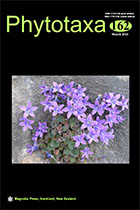Abstract
Although the phylogeny of the genus Kappaphycus has been the subject of a number of published studies, the phylogenetic placement of Kappaphycus inermis within the genus has remained unresolved. In this study, we sought to determine the phylogenetic affinities of K. inermis with the other congeneric species using mitochondrial (cox1 and cox2–3 spacer) and plastid (rbcL and RuBisCo spacer) markers, using specimens collected from northwestern Philippines. Morphological observations of the collected materials confirmed the presence of key morphological features that distinguish K. inermis from the other members of Kappaphycus. Molecular analyses based on the organellar genetic markers revealed that K. inermis is indeed phylogenetically distinct from K. alvarezii, K. striatus, K. cottonii and K. malesianus, a species which was recently erected based on specimens from Malaysia. The Philippine K. inermis specimens formed a sister clade to K. malesianus (also referred to as “Aring-aring” in Malaysia) in phylogenetic trees inferred from cox1, cox2–3 spacer and rbcL, but not the RuBisCo spacer whose sequence is identical in both K. inermis and K. malesianus. The analysis also revealed that specimens of unidentified Kappaphycus species collected from two other sites in the Philippines and referred to as “Aring-aring” by local farmers/traders were varieties of K. alvarezii and K. striatus.

